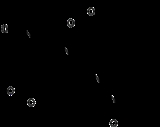
Stercobilin
Encyclopedia
Stercobilin is a tetrapyrrolic
bile pigment and is one end-product of heme
catabolism. It is the chemical responsible for the brown color of human fecal material and was originally isolated from feces in 1932. Stercobilin (and related urobilin
) can be used as a marker for biochemical identification of fecal pollution levels in rivers.
, which rapidly reduces to free bilirubin
. Bilirubin binds tightly to plasma proteins (especially albumin) in the blood stream and is transported to the liver, where it is conjugated with one or two glucuronic acid residues into bilirubin diglucuronide
, and secreted into the small intestine as bile
. In the small intestine, some bilirubin glucuronide is converted back to bilirubin via bacterial enzymes in the terminal ileum. This bilirubin is further converted to colorless urobilinogen
. Any urobilinogen that remains in the colon is converted to stercobilinogen
and finally oxidized to stercobilin, which is responsible for the brown color of human feces. Stercobilin is then excreted in the feces.
L-700,417. Further research is suggested to study the pharmacological efficacy of these pigments.
Tetrapyrrole
Tetrapyrroles are compounds containing four pyrrole rings. With the exception of corrin, the four pyrrole rings are interconnected through one-carbon bridges, in either a linear or a cyclic fashion...
bile pigment and is one end-product of heme
Heme
A heme or haem is a prosthetic group that consists of an iron atom contained in the center of a large heterocyclic organic ring called a porphyrin. Not all porphyrins contain iron, but a substantial fraction of porphyrin-containing metalloproteins have heme as their prosthetic group; these are...
catabolism. It is the chemical responsible for the brown color of human fecal material and was originally isolated from feces in 1932. Stercobilin (and related urobilin
Urobilin
Urobilin is a yellow linear tetrapyrrole, resulting from the breakdown of heme, a cyclic tetrapyrrole.Urobilin is produced when Urobilinogen is oxidized by intestinal bacteria; it can also be...
) can be used as a marker for biochemical identification of fecal pollution levels in rivers.
Metabolism
Stercobilin results from breakdown of the heme moiety of hemoglobin found in erythrocytes. Macrophages break down senescent erythrocytes and break the heme down into biliverdinBiliverdin
Biliverdin is a green tetrapyrrolic bile pigment, and is a product of heme catabolism. It is the pigment responsible for a greenish color sometimes seen in bruises.- Metabolism :...
, which rapidly reduces to free bilirubin
Bilirubin
Bilirubin is the yellow breakdown product of normal heme catabolism. Heme is found in hemoglobin, a principal component of red blood cells. Bilirubin is excreted in bile and urine, and elevated levels may indicate certain diseases...
. Bilirubin binds tightly to plasma proteins (especially albumin) in the blood stream and is transported to the liver, where it is conjugated with one or two glucuronic acid residues into bilirubin diglucuronide
Bilirubin diglucuronide
Bilirubin diglucuronide is a conjugated form of bilirubin formed in bilirubin metabolism. The hydrophilic character of bilirubin diglucuronide enables it to be water-soluble. It is pumped across the hepatic canalicular membrane into the bile by the transporter MRP2....
, and secreted into the small intestine as bile
Bile
Bile or gall is a bitter-tasting, dark green to yellowish brown fluid, produced by the liver of most vertebrates, that aids the process of digestion of lipids in the small intestine. In many species, bile is stored in the gallbladder and upon eating is discharged into the duodenum...
. In the small intestine, some bilirubin glucuronide is converted back to bilirubin via bacterial enzymes in the terminal ileum. This bilirubin is further converted to colorless urobilinogen
Urobilinogen
Urobilinogen is a colourless product of bilirubin reduction. It is formed in the intestines by bacterial action. Some urobilinogen is reabsorbed, taken up into the circulation and excreted by the kidney. This constitutes the normal "enterohepatic urobilinogen cycle".Increased amounts of bilirubin...
. Any urobilinogen that remains in the colon is converted to stercobilinogen
Stercobilinogen
Stercobilinogen is a chemical created by bacteria in the gut. It is made of broken-down hemoglobin. It is further processed to become the chemical that gives feces its brown color....
and finally oxidized to stercobilin, which is responsible for the brown color of human feces. Stercobilin is then excreted in the feces.
Obstructive jaundice
In obstructive jaundice, no bilirubin reaches the small intestine, meaning that there is no formation of stercobilinogen. As a result, no stercobilin is formed. This lack of stercobilin and other bile pigments causes feces to become clay-colored.Brown pigment gallstones
An analysis of two infants suffering from cholelithiasis observed that a substantial amount of stercobilin was present in brown pigment gallstones. This study suggested that brown pigment gallstones could form spontaneously in infants suffering from bacterial infections of the biliary tract.Role in treatment of disease
A 1996 study by McPhee et al. suggested that stercobilin and other related pyrrolic pigments — including urobilin, biliverdin, dimethyl ester, and xanthobilirubic acid — has potential to function as a new class of HIV-1 protease inhibitors when delivered at low micromolar concentrations. These pigments were selected due to a similar in shape to the successful HIV-1 protease inhibitor MerckMerck & Co.
Merck & Co., Inc. , also known as Merck Sharp & Dohme or MSD outside the United States and Canada, is one of the largest pharmaceutical companies in the world. The Merck headquarters is located in Whitehouse Station, New Jersey, an unincorporated area in Readington Township...
L-700,417. Further research is suggested to study the pharmacological efficacy of these pigments.
External links
- http://www.chem.qmul.ac.uk/iupac/tetrapyrrole/TP/D6.html

